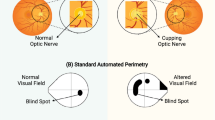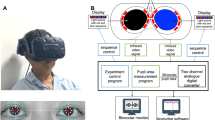Abstract
Purpose
The aim was to investigate the involvement of intrinsically photosensitive retinal ganglion cells (ipRGCs) in patients with manifest glaucoma and ocular hypertension (OH) using specific parameters of the pupil light reflex to chromatic stimuli.
Methods
Twenty-five patients with manifest glaucoma, 16 patients with OH and 16 healthy control subjects were stimulated with 28 lx red (605 nm) or blue (420 nm) light with a duration of either 1 s or 4 s. The consensual pupil light reaction was recorded by means of infrared pupillometry. The maximal relative amplitude (MRA), the post-illumination pupil response PIPRblue-red, and the slope of the response during exposure to the 4 s red stimulus (SORRS) were calculated and compared using ANOVA and Tukey-Kramer post-hoc tests. Correlations between pupil parameters and visual field defects were analyzed using Pearson correlation coefficient r.
Results
PIPRblue-red was reduced in glaucoma patients compared to normals (p < 0.001) and OH (p < 0.01). There was no significant difference between OH and normals. Glaucoma patients showed additionally reduced MRA for red and blue light (p < 0.05) and a pupillary escape during exposure to red light (increased SORRS, p < 0.0005). This pupillary escape could also be seen in single subjects with OH. Significant correlations between pupil parameters and visual field defects were detected.
Conclusions
The reduced PIPRblue-red indicates a characteristic impairment of the melanopsin-driven pathway of ipRGCs in glaucoma patients, whereas the reduced MRA and increased SORRS suggest a disturbed synaptic function and altered interaction between outer photoreceptors, RGCs, and ipRGCs.






Similar content being viewed by others
References
Friedman DS, Wilson MR, Liebmann JM, Fechtner RD, Weinreb RN (2004) An evidence-based assessment of risk factors for the progression of ocular hypertension and glaucoma. Am J Ophthalmol 138(3 Suppl):19–31
Kass MA, Heuer DK, Higginbotham EJ et al (2002) The ocular hypertension treatment study: a randomized trial determines that topical ocular hypotensive medication delays or prevents the onset of primary open-angle glaucoma. Arch Ophthalmol 120:701–713
Skorkovská K, Kelbsch C, Blumenstock G, Wilhelm H, Wilhelm B (2012) Glaucoma screening by means of pupil campimetry. Klin Monbl Augenheilkd 229(11):1097–1102
Provencio I, Rodriguez IR, Jiang G, Hayes WP, Moreira EF, Rollaq MD (2000) A novel human opsin in the inner retina. J Neurosci 20(2):600–605
Dacey DM, Liao HW, Peterson BB et al (2005) Melanopsin expressing ganglion cells in primate retina signal colour and irradiance and project to the LGN. Nature 433:749–754
Berson DM, Dunn FA, Takao M (2002) Phototransduction by retinal ganglion cells that set the circadian clock. Science 295(5557):1070–1073
Hattar S, Liao HW, Takao M, Berson DM, Yau KW (2002) Melanopsin-containing retinal ganglion cells: architecture, projections, and intrinsic photosensitivity. Science 295:1065–1070
Hattar S, Lucas RJ, Mrosovsky N et al (2003) Melanopsin and rod-cone photoreceptive systems account for all major accessory visual functions in mice. Nature 424:76–81
Gamlin PD, McDougal DH, Pokorny J, Smith VC, Yau KW, Dacey DM (2007) Human and macaque pupil responses driven by melanopsin-containing retinal ganglion cells. Vis Res 47:946–954
Schmidt TM, Do MTH, Dacey D, Lucas R, Hattar S, Matynia A (2011) Melanopsin-positive intrinsically photosensitive retinal ganglion cells: from form to function. J Neurosci 31(45):16094–16101
Qiu X, Kumbalasiri T, Carlson SM et al (2005) Induction of photosensitivity by heterologous expression of melanopsin. Nature 433:745–749
Lucas RJ, Douglas RH, Foster RG (2001) Characterization of a novel ocular photopigment capable of driving pupillary constriction in mice. Nat Neurosci 4:621–626
Brown TM, Gias C, Hatori M et al (2010) Melanopsin contributions to irradiance coding in the thalamo-cortical visual system. PLoS Biol 8, e1000558
Li RS, Chen B, Tay DK, Chan HHL, Pu M, So K (2006) Melanopsin-expressing retinal ganglion cells are more injury-resistant in a chronic ocular hypertension model. Invest Ophthalmol Vis Sci 47:2951–2958
Kankipati L, Girkin CA, Gamlin PD (2011) The post-illumination pupil response is reduced in glaucoma patients. Invest Ophthalmol Vis Sci 52:2287–2292
Feigl B, Mattes D, Thomas R, Zele AJ (2011) Intrinsically photosensitive (Melanopsin) retinal ganglion cell function in glaucoma. Invest Ophthalmol Vis Sci 52:4362–4367
Esterman B (1967) Grid for scoring visual fields. Arch Ophthalmol 77:780–786
Nissen C, Sander B, Milea D et al (2014) Monochromatic pupillometry in unilateral glaucoma discloses no adaptive changes subserved by the ipRGCs. Front Neurol 5:15
Pitsas C, Papaconstantinou D, Georgalas I, Halkiadakis I (2015) Relationship between short-wavelength automatic perimetry and Heidelberg retina tomograph parameters in eyes with ocular hypertension. Int J Ophthalmol 8(5):1013–1017
Gordon MO, Beiser JA, Brandt JD et al (2002) The ocular hypertension treatment study: baseline factors that predict the onset of open-angle glaucoma. Arch Ophthalmol 120(6):714–720, discussion 829–830
Zele AJ, Feigl B, Smith SS, Markwell EL (2011) The circadian response of intrinsically photosensitive retinal ganglion cells. PLoS One 6(3), e17860. doi:10.1371/journal.pone.0017860
Lei S, Goltz HC, Chandrakumar M, Wong AMF (2014) Full-field chromatic pupillometry for the assessment of the postillumination pupil response driven by Melanopsin-containing retinal ganglion cells. Invest Ophthalmol Vis Sci 55:4496–4503
Acknowledgments
We thank Dr. Anne Kurtenbach for her help with the manuscript.
Author information
Authors and Affiliations
Corresponding author
Ethics declarations
Funding
The Egon Schumacher-Stiftung, Germany, a private foundation without commercial interest, provided financial support in the form of labour and material costs funding. The sponsor had no role in the design or conduct of this research.
Conflict of interest
All authors certify that they have no affiliations with or involvement in any organization or entity with any financial interest, or non-financial interest in the subject matter or materials discussed in this manuscript.
Ethical approval
All procedures performed in this study were in accordance with the ethical standards of the local institutional ethics committee and with the 1964 Helsinki declaration and its later amendments or comparable ethical standards.
Informed consent
Informed consent was obtained from all individual participants included in the study.
Rights and permissions
About this article
Cite this article
Kelbsch, C., Maeda, F., Strasser, T. et al. Pupillary responses driven by ipRGCs and classical photoreceptors are impaired in glaucoma. Graefes Arch Clin Exp Ophthalmol 254, 1361–1370 (2016). https://doi.org/10.1007/s00417-016-3351-9
Received:
Revised:
Accepted:
Published:
Issue Date:
DOI: https://doi.org/10.1007/s00417-016-3351-9




